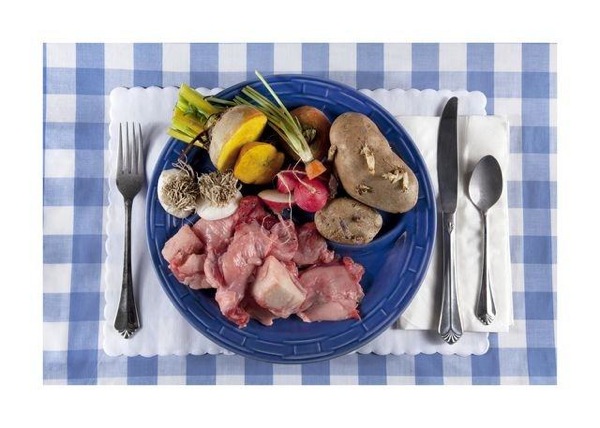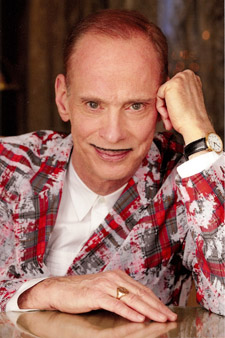
John Waters, the Baltimore-based cult film auteur and artist (known as the “Pope of Trash” by fans), wants to give Minnesotans a meal they’ll never forget. And you can find it, strangely enough, at the Garden Cafe at the Walker Art Center in Minneapolis.
Earlier this year, the Walker gave Waters the keys to the kingdom, allowing him to tweak and rearrange the museum as part of his curated exhibition, “Absentee Landlord” (on view until March 2012). Choice “infections” include the sounds of cars crashing in the parking garage, and the open display of bills and receipts pertaining to the exhibition.
And, of course, the Blue Plate Special at the cafe: a photograph, taken by Waters, of a most unappetizing meal of meat gristle, sprouted potatoes, and assorted vegetable trimmings. What makes this even better is the fact that a framed print of the photo is fittingly placed right above a display case of ready-made food. The Walker is selling a limited number of prints (signed and numbered by Waters) at the cafe for $150 a piece.
The Heavy Table got Waters on the phone to get the story behind the photograph.
Heavy Table: Could you give us the context of the photograph? Where did the idea start?

John Waters: Well, I did all of those things at the Walker — the car crash noises in the garage, the audio tours in Pig Latin — and I realized that I hadn’t infected the lunchroom yet. So I thought, rather than serve food as something artful, why don’t we try serving art as food? And I have tons of food art at home, too. [Swedish sculptor] Claes Oldenburg is definitely an influence. It’s food that you only look at and never have to eat.
And no one would really eat what’s on that plate unless they were crazy! But some restaurants do serve those things; I was served carrot tops once at a really nice restaurant. I’m also inspired by the aesthetic of purposeful mistakes that’s in Japanese fashion right now, the idea of putting out seconds, or flawed things that are normally hidden from the public.
HT: What was the process like?
JW: I was assisted by food stylist Sascha Wolhandler — she’s worked with me on movies and catered some parties for me. It was fun. She brought in so many different kinds of rotten meat. We purchased real placemats, like you’d see in an older type of diner, from eBay. Real diners don’t even use placemats anymore, but we were trying for that certain look. It’s actually very compositionally similar to something I did for my film, Desperate Living. Except instead of food, there was a big rat on the plate.
HT: You wrote in your memoir, Role Models, that the job of contemporary art is “to infuriate.” Is that what you mean to do with this piece?
JW: Yes, I definitely believe that. Art is supposed to be a total change from what came before. It’s a tradition to anger some people, and give others a new way of seeing. Like looking at meat gristle in a new way, in a new context. Maybe now, every time you look at gristle, you can stop yourself before you toss it out and think, “That’s kind of beautiful.”
My motivation has always been humor. Humor changes how people look at things. Blue Plate Special deals with the way food is pushed in museums. Typically, people who buy art also buy fancy food. So this is like the reverse of the foodie aesthetic! They can buy an image of the things that are generally thrown away; because they’re art materials, they have a positive value. I mean, at the bare minimum, would the Blue Plate Special pass a food inspection? Maybe this meal even breaks the law! And no, we didn’t eat it — or rather, we chose not to.
I don’t think the plate is repulsive — after all, gristle is only one inch away from steak tartare. In a sense, all food is disgusting. Don’t get me wrong, I’m not food averse or anything like that. It’s just that we all have to eat, it’s an instinct. And I resent instinctual impulses because I didn’t think them up! Food is kind of repellent, because eating is fundamentally humiliating.
HT: Speaking of which, are you also expressing something about haute cuisine with this?
JW: So, my favorite restaurant is Prune in New York City. Prune and a lot of restaurants like it present really amazing twists on traditional comfort food. And with Blue Plate Special, I went a little further with that twist. For art, it’s pretty inexpensive — about the cost of a really fancy restaurant meal. And I don’t mean to offend, but you’re eventually going to shit that meal out. If you think about it, my photograph is kind of a better deal. You can look at it forever.

Check out this article from yesterday’s NY Times, “That’s Not Trash, That’s Dinner”, on “stem-to-root” cooking. Waters is ahead of his time, again: http://nyti.ms/nJxg6Q
There is a difference between a museum and a gallery. A museum displays art, and a gallery sells art. The two should never be confused. Not even in the cafe or museum shop. Museums can sell approved reproductions, but not signed and numbered prints, original works of art, or any other item limited by the artist. This is in my mind a wrong step, and one I opposed (with the support of the curators) while working at the museum store at the Milwaukee Art Museum.
Wrong steps are what John Waters is all about ;)
NOT a fan of John Waters!
And I don’t mean to offend, but you’re eventually going to shit that meal out. If you think about it, my photograph is kind of a better deal. You can look at it forever.
how much do i love this.